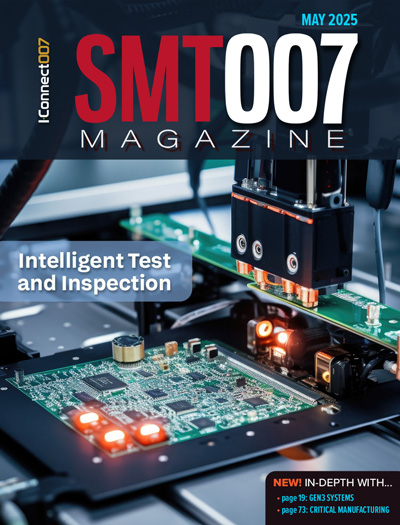-

- News
- Books
Featured Books
- smt007 Magazine
Latest Issues
Current Issue
What's Your Sweet Spot?
Are you in a niche that’s growing or shrinking? Is it time to reassess and refocus? We spotlight companies thriving by redefining or reinforcing their niche. What are their insights?

Moving Forward With Confidence
In this issue, we focus on sales and quoting, workforce training, new IPC leadership in the U.S. and Canada, the effects of tariffs, CFX standards, and much more—all designed to provide perspective as you move through the cloud bank of today's shifting economic market.

Intelligent Test and Inspection
Are you ready to explore the cutting-edge advancements shaping the electronics manufacturing industry? The May 2025 issue of SMT007 Magazine is packed with insights, innovations, and expert perspectives that you won’t want to miss.
- Articles
- Columns
- Links
- Media kit
||| MENU - smt007 Magazine
ASM Opens Up New Possibilities in High-Volume Solder Paste Printing
September 24, 2020 | ASM Assembly SystemsEstimated reading time: 2 minutes
With an update, technology leader ASM presents additional functions for its high-volume DEK TQ printer, which sets new records in terms of speed, floor space performance and wet-printing accuracy. With its perfectly matched combination of print head, paste dispenser and innovative understencil cleaning system, the DEK TQ can operate for up to 8 hours without an operator assist. With its new hardware and software options, the printer features even more capabilities now. The innovations comprise its offline programming, the DEK TQ V1 operating software, the High Flow Vacuum board support system, and the intelligent and flexible verification and traceability functions.
With new options and software enhancements, technology leader ASM further improves the operability and capabilities of its DEK TQ stencil printer. The High Flow Vacuum function, for example, provides an affordable and highly efficient board support solution for the high-volume production of small and highly complex PCBs.
The new and highly flexible and intelligent verification function allows the verification of all printer materials either by means of the ASM OIB, with an interface to a higher-level MES (ideal for testing and releasing the solder paste) or individually selectable against a reference on the DEK TQ for supports, squeegees, etc.
Together with the sophisticated traceability functions, this provides an ideal connection of the DEK TQ to the Smart Factory.
New software
The DEK V1 station software and SIPLACE Pro have been revised from the ground up. With ASM Printer Programming and its integration into SIPLACE Pro, central program management is being raised to a new level. Printing programs are now administered across lines, printing and placement programs downloaded jointly to SMT lines, and each printer’s features are verified automatically before a program is executed.
DEK TQ – the standard for high-volume production
The DEK TQ sets new standards in performance, efficiency and precision. In a footprint of only 1.3 by 1.0 meters, the high-volume printer achieves a core cycle time of as little as five seconds for maximum throughput. With its use of precise linear drives, off-belt printing, innovative clamping systems and an advanced print head, the DEK TQ achieves a wet-printing accuracy of ±17.5 µm @ 2 Cpk – more than enough to reliably print the pads for 0201 metric components and modern ultra-fine-pitch applications. Each machine comes with an external capability certification. Open interfaces like IPC-Hermes-9852, Closed-Loop-to-SPI, ASM OIB and IPC CFX make it easy to integrate the DEK TQ into a smart integrated factory. They also deliver additional investment protection. With its highly efficient understencil cleaning system featuring an extra-large fabric roll and additional tanks as well as its automatic print head and dispenser system, the printer can run for up to 8 hours with no operator assist.
Suggested Items
KYZEN to Highlight Understencil and PCB Cleaners at SMTA Querétaro Expo and Tech Forum
07/09/2025 | KYZEN'KYZEN, the global leader in innovative environmentally responsible cleaning chemistries, will exhibit at the SMTA Querétaro Expo & Tech Forum, scheduled to take place Thursday, July 24, at Centro de Congresos y Teatro Metropolitano de Querétaro.
Driving Innovation: Direct Imaging vs. Conventional Exposure
07/01/2025 | Simon Khesin -- Column: Driving InnovationMy first camera used Kodak film. I even experimented with developing photos in the bathroom, though I usually dropped the film off at a Kodak center and received the prints two weeks later, only to discover that some images were out of focus or poorly framed. Today, every smartphone contains a high-quality camera capable of producing stunning images instantly.
Hands-On Demos Now Available for Apollo Seiko’s EF and AF Selective Soldering Lines
06/30/2025 | Apollo SeikoApollo Seiko, a leading innovator in soldering technology, is excited to spotlight its expanded lineup of EF and AF Series Selective Soldering Systems, now available for live demonstrations in its newly dedicated demo room.
Indium Corporation Expert to Present on Automotive and Industrial Solder Bonding Solutions at Global Electronics Association Workshop
06/26/2025 | IndiumIndium Corporation Principal Engineer, Advanced Materials, Andy Mackie, Ph.D., MSc, will deliver a technical presentation on innovative solder bonding solutions for automotive and industrial applications at the Global Electronics A
Fresh PCB Concepts: Assembly Challenges with Micro Components and Standard Solder Mask Practices
06/26/2025 | Team NCAB -- Column: Fresh PCB ConceptsMicro components have redefined what is possible in PCB design. With package sizes like 01005 and 0201 becoming more common in high-density layouts, designers are now expected to pack more performance into smaller spaces than ever before. While these advancements support miniaturization and functionality, they introduce new assembly challenges, particularly with traditional solder mask and legend application processes.


